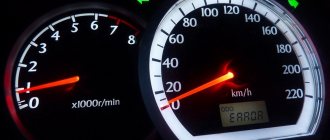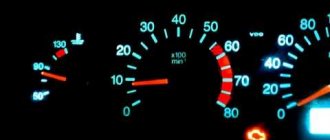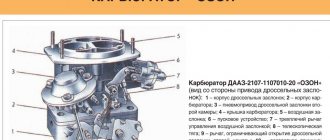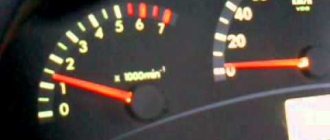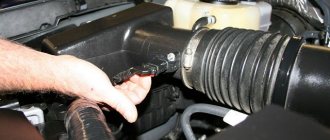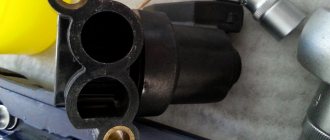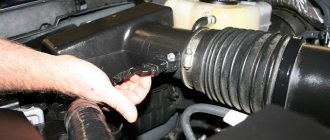VAZ 2107 is the latest model of the Zhiguli, available with rear-wheel drive. In essence, this is the “Five”, which has increased engine power, improved design and exterior. The car was produced with various engine sizes, ranging from 1.45 to 1.7 liters. Until 2006, the “Seven” had a carburetor engine, but during the transition to Euro-2, the designers developed and installed a forced fuel injection system, i.e. injectors.
With the introduction of injection engines, car enthusiasts felt positive changes in the operation of these cars.
All mechanisms are subject to wear and tear and fail over time. The forced injection system is no exception; during operation it acquires a number of malfunctions.
In VAZ 2107 cars, the engine sometimes stops working while idling. It happens that the engine stalls, but after starting it works properly. After some time this happens again. This means that the breakdown exists and will still have to be fixed. The reason is most likely in the throttle assembly, or more precisely in the idle air controller (IAC).
PURPOSE AND DEVICE OF IDLE CONTROL.
The idle speed regulator is designed to regulate the amount of atmospheric air entering through the bypass channel (bypass) into the suction manifold when the engine is idling. The main channel is closed by the throttle valve.
The regulator is a DC electric motor. It has two windings on the stator and a rotor with permanent magnets. The rotor is connected to the rod by a lead screw. At the end of the rod there is a valve that closes the hole in the bypass. Power is supplied either to the first or to the second stator winding. At the same time, the rotor rotates in one direction and then in the other, extending or retracting the rod and the valve with it using a screw.
About air leaks
The penetration of foreign air into the cylinders of a running engine is imperceptible while driving, since the proportion of non-flammable gas is relatively small. But “floating” and high engine speeds appear at idle, when little fuel is supplied to the chambers. Air leakage due to the movement of the pistons is possible from the following places:
- gaskets under collectors and at other joints;
- broken vacuum booster of the brake system;
- throttle body;
- various vacuum connections;
- adsorber purge system.
To detect air leaks at gaskets and joints, you can use another old method. Fill the syringe with gasoline and squeeze the fuel onto the suspected leak. The operation is performed with the engine running. If fuel penetrates into an invisible gap, it will inevitably be drawn by the pistons into the combustion chambers. The speed of the power unit will increase and will not decrease until you stop filling the gap with gasoline.
The reasons for the floating idle, the VAZ injector and its malfunction, as one of the possible reasons - such questions concern many car enthusiasts. When a breakdown occurs in a beloved car, the owner experiences the same worry as if he himself was sick. And therefore, while traveling, from time to time he listens to see if the car is working normally, if there are any suspicious extra noises.
OPERATING PRINCIPLE OF IAC.
SPVT (Forced fuel injection system) has its own “brain”, which receives all the information from the sensors, processes it and issues commands to the actuators for the optimal functioning of the internal combustion engine (ICE). This “brain” is called a controller or ECU (Electronic Control Unit). IAC refers to the actuators controlled by the controller.
At the moment of start-up, the regulator opens a hole in the bypass. Air enters the suction manifold through it. The engine starts running. As the engine warms up, the valve closes, reducing the air supply. The speed is stabilized to a minimum.
When the throttle valve is opened, the main flow of air is supplied to the engine through the main channel. In this case, the regulator closes the hole in the bypass. To smoothly control the idle air control, the ECU receives additional information from sensors: throttle position, air flow, crankshaft position and tachogenerator.
When additional loads on the engine arise (turning on a radiator fan, heater, etc.), the regulator opens a hole in the bypass. This makes it possible to maintain power and prevent engine failures.
Checking the electro-pneumatic valve control unit.
You will find the control unit for the EPHH electro-pneumatic valve on the left mudguard in the engine compartment.
Gradually increase engine speed. At engine speeds of 1500–2000 rpm, the voltmeter readings will drop abruptly to 0.5–1.5 V or the warning light will go out.
We replace the faulty unit with a new one, for this...
4. ...disconnect the connector...
5. ...and use a screwdriver to unscrew the two screws securing the block to the mudguard. Next, we install the new EPHH block in reverse order.
UNSTABLE OPERATION OF INJECTION ENGINE.
Engine instability can be due to a failure in any system. Either:
- ignition;
- fuel supply;
- electronic control unit
- wear of moving parts and engine components.
To understand this, it is necessary to check the performance of systems using the elimination method. Let's look at an ECU as an example.
The engine is warmed up, but vibration and increased speed are felt during operation. Perhaps this is an accumulation of errors in the controller memory. To reset them, you need to turn off the engine and turn off the “mass” for 15 minutes. After that, start the engine. If there are no changes in engine operation, then the reason is in the ECU sensors.
When any of the sensors does not work, the ECU has to rely only on the data from the working devices. This is not enough for normal management of SPVT. The engine does not work correctly:
- Unstable crankshaft speed.
- Increased gasoline consumption, highly enriched mixture.
- There is black smoke on the exhaust.
- Soot or soot on spark plug electrodes.
This occurs due to a lack of data entering the control unit, such as:
- air flow;
- amount of oxygen in exhaust gases;
- throttle position;
- crankshaft position;
- temperatures;
- speed;
- or IAC failure.
To check the functionality of the sensors, you need to disconnect the wire connectors one by one and observe how the internal combustion engine operates. If there are no changes, then the device that is turned off has failed.
Most often, malfunctions occur in the idle air regulator.
How to get rid of problems caused by a drop in speed
A failure in the engine during significant acceleration can occur for various reasons - this has already been dealt with. These reasons vary depending on what type of engine is installed in the car: carburetor or injection. Accordingly, methods for troubleshooting also vary. We have to deal with this now.
Checking the carburetor system
Initially, the operation of the fuel system is checked to see how smoothly and correctly it works. Every working unit and detail matters. Air leaks are checked, fuel lines are examined and the fuel pump is diagnosed. All blockages and deposits are removed.
Fuel pump
If the diagnostics do not reveal any problems, then the carburetor may cause a failure in the engine when the gas pedal is pressed. This part is responsible for supplying fuel. During normal operation of the carburetor, fuel is supplied without interruption, constantly and evenly.
To identify and eliminate the cause of the problem, you must proceed as follows:
- We exclude air leaks, which may occur due to a loose fastening on the exhaust manifold.
- We study the condition of the mesh-type filter, which is located in the area where the pipe from the fuel pump connects.
- We dismantle the EPH valve and the sealing ring and examine their condition. If the EPHH is working properly, then when you connect one side of the wire to the terminal, and the opposite end to the positive terminal of the battery, a clicking sound will be heard.
- Check the liquid level in the float chamber. To do this, start the engine, leave it to run for a while, remove the top carburetor cover and filter housing. Now let's evaluate the fuel level. In normal condition, it should be in the middle of the inclined wall.
- The dosing system may become clogged and this is a common problem. To eliminate it, you will need to remove the top part of the dispenser and the jets. We look for blockages and remove them using wooden parts. Emulsion tubes, which are often forgotten, also need inspection and maintenance.
- Special products are used to clean the carburetor channels.
Drop in speed on injection models
In the case of injection cars, when failures occur in the engine, the fuel supply system is first checked to see how well this system works
What you need to pay priority attention to:
- Is there a blockage on the fine filter?
- The fuel pump operates stably.
- Clean filter mesh on the intake.
- Is the fuel rail pressure normal? The norm for this indicator starts from 2.8 and reaches 3.2 Bar.
- The sensors that regulate the formation and supply of the fuel mixture are functioning normally.
- How many errors have accumulated in the ECU?
- The throttle valve has collected debris.
- Injectors can cause failures in the operation of an injection engine when you press the gas pedal. We definitely check their functionality.
To carry out a complete diagnosis with your own hands, you need a multimeter and a pressure gauge. Some working components (injectors, throttle valve, ECU) can only be checked by specialists. If the cause has not been identified, then you need to check the ignition system
First of all, pay attention to the spark plugs. Then the wiring, main operating components and the installation itself are checked. Don't delay in solving the problem
It will not go away on its own, the situation will only get worse. Ultimately, more serious problems with the vehicle may arise that will take longer and be more expensive to fix. Moreover, the risk of accidents increases significantly. But you can’t skimp on safety; not only your life is at risk, but also that of other road users
Do not delay in solving the problem. It will not go away on its own, the situation will only get worse. Ultimately, more serious problems with the vehicle may arise that will take longer and be more expensive to fix. Moreover, the risk of accidents increases significantly. But you cannot skimp on safety; not only your life is at risk, but also that of other road users.
SIGNS OF IAC MALFUNCTION.
There are several of them. They are all noticeable.
- Unstable engine speed at idle.
- Floating engine speed.
- When the engine is loaded, power drops sharply.
- Until you press the gas pedal, the internal combustion engine will not start.
- When you release the gas pedal, the internal combustion engine stalls.
- High idle speed.
The above symptoms may also occur in case of malfunctions of other SPVT equipment. To be convincing, it is necessary to confirm the inoperability of the IAC by conducting diagnostics at a service station, or independently.
Checking the EPHH needle valve.
We also remove the hose from the side outlet (fitting “2”) of the electro-pneumatic valve and connect this hose to the economizer. We start the engine. If the economizer valve is working properly, the engine should run at low speed. If the engine stalls at idle, the valve diaphragm may rupture.
To change the valve, disconnect the wires from the microswitch terminals.
2. Using a screwdriver, unscrew the two screws securing the economizer housing to the carburetor.
3. Remove the bracket with the microswitch...
4. ...as well as the economizer assembly.
5. Remove the gasket from the economizer.
6. Unscrew the two bolts holding the body and economizer cover together...
7. We halve the economizer and check the condition of the diaphragm.
If the diaphragm is defective or the needle and seat are worn, we replace the economizer assembly.
On older models it was possible to change parts individually.
We install the new economizer in the reverse order.
CHECKING THE ELECTRICAL IAC CIRCUIT
What can you do yourself when checking the electrical circuit of the idle speed control of a VAZ 2107? Measuring the voltage at the connection block to the control unit and measuring the resistance of the regulator motor windings. To measure you need to have a tester.
The diagnostic procedure is given below:
- Disconnect the block with the wiring harness from the regulator. It is located on the throttle assembly.
- Turn on the ignition.
- Set the tester to voltage measurement mode in the range from 0 to 20 volts.
- Connect the probe from the tester with a minus sign to the ground of the car.
- Connect the probe from the tester with the “plus” sign in turn to terminals “A” and “D” on the harness block. The voltage between ground and terminals should be 12 volts. If there is no voltage, the controller may not be corrected.
- Next, move the tester to the resistance measurement position. Measure the resistance of the first winding between terminals “A” and “B”. Measure the resistance of the second winding between terminals “C” and “D”. There should be 52 ohms on both windings. In other variations of measurements between the terminals, the device should indicate an open circuit. If the tester shows the opposite, then the electric motor is faulty.
IAC malfunction.
The electric motor is not the only component in the regulator that can break; there are a number of other breakdowns:
- oxidation of connector contacts, broken wires;
- contamination of the rod, preventing movement;
- the o-ring is torn;
- wear of the screw thread on the rod.
Of the above breakdowns, the most common is contamination of the rod. If during operation the throttle assembly has not been maintained for a long time, carbon deposits on the regulator rod are possible. To remove dirt, you need to remove the IAC and rinse with acetone.
The stem needs to be cleaned periodically. Otherwise, the load increases, which can damage the ECU. Then you will have to contact service station specialists.
Problems in the mass air flow sensor - mass air flow sensor.
The mass air flow sensor is located in the air duct between the throttle valve and the air purification filter. It shows the volume of air entering from the atmosphere into the suction manifold. Based on these data, the control unit calculates the amount of fuel required for the current operating mode of the internal combustion engine.
If the sensor is faulty, the “Check Engine” light on the panel lights up. In parallel with this, a number of signs of failure are possible:
- Fuel consumption has increased.
- Idle speed is increased.
- The dynamics of the car are disrupted due to a decrease in power.
- It is impossible to start the internal combustion engine, even when “hot”.
- The speed changes at any throttle position, even under engine load.
Such sensors are not repaired, but replaced. Therefore, you need to make sure that this is the reason. Often the cause may be contamination of the platinum thread inside the device; it can be cleaned. Or the cause of air leakage through a damaged air duct.
Air leaks through cracks in hoses and seals.
There are many places where excess air can enter the suction manifold, bypassing the mass air flow sensor. The fuel mixture becomes leaner, the speed decreases, and the power drops. The ECU tries to correct these errors. A failure occurs in the system, the speed and “thrust” do not correspond to the specified parameters. The "Check Engine" warning light on the dashboard does not light up. The conclusion from this is that the sensors are working, but the internal combustion engine is sucking in air somewhere.
There are several places for air leaks that you should pay attention to, these are:
- the manifold with its gaskets, all kinds of joints, gaskets under the equipment attached to the manifold;
- vacuum brake booster and its hoses:
- throttle body;
- vacuum pipes.
After eliminating these shortcomings, the power unit will operate normally.
Other reasons.
A car is a complex engineering structure. During operation, its units, components, systems, and blocks are subject to wear. And it is impossible to describe all combinations of breakdowns.
Here are some reasons for the internal combustion engine not working properly:
- The ignition system has many of its own “sores”.
- Nozzles requiring professional care.
- Low quality gasoline.
- Presence of water in the fuel tank.
- Fuel and air filters are clogged.
- Other.
In each case it is necessary to understand, identify cause and effect. If you can’t do it yourself, you should contact a service station specialist.
In this article, “Why do idle speeds fluctuate on a VAZ 2107 injection engine,” the emphasis is on the breakdown of the XX Regulator. If it is broken, it can hardly be repaired. It's better to change it. It’s not difficult to do it yourself, having a new IAC and a minimum of tools.
Carrying out diagnostics
The simplest method is to measure the voltage at the block to which the regulator is connected. These are terminals D and A. When the ignition is turned on, a voltage of 12 V should be present on them. If the voltage is less than this value, it is worth looking at the battery and generator. It is quite possible that the battery is undercharged. In the same case, if there is no voltage at all, it is necessary to check the entire power circuit of the device and diagnose the ECU.
REPLACING THE IDLE CONTROL.
In addition to the tool, you need to prepare some consumables. First of all, the regulator itself. Throttle assembly gasket and rubber ring for idle air control. 300 milliliters of coolant (you will have to add it) and a rag. To change the IAC, you must:
- Raise the hood, turn off the ground.
- Disconnect the accelerator drive from the throttle.
- Disconnect all wires leading to the regulator and throttle.
- Loosen the clamps and remove the coolant inlet and outlet hoses.
- Loosen the clamp on the breather hose and disconnect the hose.
- Disconnect the air supply pipe from the throttle body.
- Remove the fuel vapor exhaust hose from the throttle body.
- Unscrew the nuts securing the throttle assembly to the manifold.
- Remove the throttle assembly from the studs.
- Unscrew the screws securing the regulator.
- Remove the regulator.
Thus, the IAC is removed. To install a new regulator, all steps are performed in reverse order. It is better to take new gaskets and sealing rings.
Do not start the engine immediately after replacing the regulator. It is necessary to turn on the ignition, wait 20-30 seconds, turn off the ignition. This time will provide an opportunity to calibrate the IAC in the ECU. After this, you can start the engine.
As a rule, when starting, the speed of a cold engine will be increased, around 1500 rpm, and when warmed up, it will drop to 800 rpm.
The video clearly shows how you can eliminate one of the reasons for floating idle speed on an injection VAZ 2107:
Checking the electro-pneumatic valve.
We turn on the ignition, thereby applying voltage to the valve output. Having produced a characteristic click, the valve of fitting “1” should open and close when the ignition is turned off.
4. The faulty electro-pneumatic valve is replaced with a new one. To change the valve, use an “8” wrench to unscrew the valve securing nut.
We connect the hoses like this, from the carburetor economizer to the side fitting, and connect the hose coming out of the intake manifold to the central fitting.
What are the reasons for the floating idle speed of vases?
Why does the speed of the VAZ-2114 jump when the engine is cold? Sometimes the engine begins to behave atypically if the idle speed fluctuates. Owners of a VAZ car know that such a situation may arise, since this is typical for domestic cars.
Unstable idle: what is the reason? There are the most common reasons for this phenomenon, and knowing them, you can easily navigate and decide what to do.
From time to time the motor, which is in warm-up mode, begins to rotate at an unstable frequency, trots, and vibrates. If there are strange popping noises in the muffler, this indicates that the fuel mixture has become over-rich in the muffler, and if such problems appear in the carburetor, then the mixture is over-lean.
The instability of the speed mainly depends on the fuel mixture that enters the cylinders at idle speed in the VAZ. If the idle speed with a cold engine malfunctions, it is possible that a foreign body has entered, a small speck in the channel is enough.
The problem may arise from the idle speed sensor. To study this unit, you need to try to remove the VAZ from speed at idle. If it does not stall, the heater and headlights turn on. If the speed does not drop, then everything is fine in this part. But if there is a problem in this part, it means that the adjustment was made incorrectly, and therefore the fuel mixture is lean at idle.
Supply system
The power system also plays a big role in the stable operation of a car engine, so it should be considered as carefully as the ignition system. Below are the main problems with the fuel system that can lead to unstable engine operation:
- The first step is to check the quality of the fuel. Try draining all the gasoline from the tank and checking it for foreign particles, such as water. Even at trusted gas stations, you can sometimes get enough water into the tank, after which the car will jerk and the engine will run erratically. In this case, when gasoline is drained from the tank, it is necessary to completely bleed the fuel line with a pump so that there are no residues of low-quality fuel left in it. If necessary, it is worth flushing the carburetor and also replacing the fuel filter.
- The carburetor or fuel filter is clogged. If debris gets into the carburetor, the engine may refuse to work or even start. If the jets are clogged, the fuel mixture will not fully enter the combustion chamber, which will instantly affect the normal operation of the engine.
- If unstable idle speed is detected, you can try to adjust the carburetor by tightening the required adjusting bolt in the carburetor.
- Gasoline pump. It may begin to act up and pump intermittently, which can naturally lead to the symptoms described.
How to adjust idle speed
The speed can be adjusted using screws. They are available on carburetors specifically designed for VAZ.
A floating idle may occur if there is a malfunction in the mass air flow sensor.
You can check this by finding out the voltage, which, as a rule, during normal operation is 0.99-1.00. To do this, the multimeter must be set to 20 V, and measurements are taken between two wires; they are easy to find - by the green and yellow colors when the car is running. If the multimeter produces different numbers, the sensor needs to be replaced.
When the cause is a faulty wiring of the speed sensor, such a defect can be noticed visually. Wiring can:
- get damaged;
- oxidize;
- wear out.
In all cases, it needs to be replaced and the contacts cleaned, even if there is the slightest oxidation.
If the sensor responsible for the crankshaft position is faulty, the first thing to do is check the wires that go to it.
If no damage is noticed here, a multimeter should be connected to the sensor, and the crankshaft should be set so that it is in a position where the highest voltage is 200 mV. If you pass a screwdriver over the core and voltage surges are shown on the device screen, the sensor is in good condition and works normally.
Tools and equipment for work
To carry out maintenance work you will need:
- A set of standard keys;
- Screwdrivers;
- Pliers;
- Rags;
- Carburetor cleaner (“Carb Cleaner” or equivalent);
This is interesting: What causes engine overheating?
You will also need a repair kit for the carburetor. Various types of repair kits are available, some of which include only gaskets, while others include all parts (jets, screws, emulsion tubes, etc.). It is better to purchase a complete set.
Since the carburetor consists of many small parts, disassembling it into its component parts, washing and troubleshooting and tuning is carried out in stages so as not to lose sight of anything.
Injector malfunction as a cause of floating idle
There are other reasons for the malfunction. If the speed drops on a VAZ-2115 or 2107, the throttle assembly may be faulty, and the reason may be hidden in the throttle valve. If it has difficulty moving, it needs to be removed and cleaned. The sensor that records the position of the injector requires measurements. You need to find out the voltage between the minus and the slider contact.
When the injector on a VAZ-2107 is closed, the voltage in this case should be 0.7 V. When it is open - 4 V. If the numbers are incorrect, the sensor must be replaced. On the VAZ-2115, the injector is often the source of a malfunction, so the throttle assembly must be cleaned.
When the previous systems are in order, you should check the idle air valve solenoid. His revision is that first of all the power is turned off and after that the car starts. To check, the wire is brought to the negative contact and to the positive one. There should be a click. If there is no click during these actions, it means that the valve is not working, and because of this the idle speed is floating.
If a click occurs, the EPH system is checked, which automatically turns off the fuel supply to the idle system at revolutions above 1200 per minute, or when idling becomes forced.
If there is a malfunction in the valve, then its needle completely blocks the hole from which fuel is supplied to the idle system, and then the engine begins to stall.
The check light is on in the car if the fault is in the spark plugs. They need to be unscrewed to check if there is carbon deposits or damage on them, since often due to their malfunction the idle speed floats.
It is best not to clean them, but to replace them with new ones. Due to the fact that the fuel level in the carburetor float chamber is not adjusted, the spark plugs may be damaged.
If, after checking all systems, no problems are identified, all that remains is to check the air filter - perhaps it is the cause of the floating idle. It happens that it is enough to clean it for the car to start working normally.
But if everything is checked, and the idle speed is not pleasing, you will have to go to a professional service station, because it is with high-precision equipment that you can determine why the idle speed of the VAZ-2115, 2114 injection is floating.
You can clean the CXX without removing the carburetor from the engine. To do this, you need to do the following: set the crankshaft speed within 3000 rpm, turn the valve several revolutions. After this, apply gas and turn the lever on the throttle axis of the 1st chamber.
The valve is then screwed back on. Repeat the procedure a couple of times until a stable idle speed appears. In this way, the vacuum in the CXX channels increases.
How to set up a Solex carburetor
This can be done without removing the device from the car. However, in some cases you have to do this to configure some parameters. Both options are considered further. How to adjust the carburetor directly on a car?
Setting levels in float chambers
Before making adjustments, start the engine and warm it up for 10 minutes, then turn off the ignition. The following actions:
- disconnect the fuel hose from the device;
- unscrew the 5 screws securing the carburetor cover;
- disconnect the choke control cable;
- lift the lid evenly and slowly so as not to deform the floats;
- Using a caliper, measure the distance from the plane of the cover to the surface of the fuel - it should be 23-25 mm;
- if the value is incorrect, bend the float tongue in each of the chambers in the desired direction;
- At the same time, clean the cameras from dirt;
- put the cover in place, then you need to install the dismantled elements.
Adjusting the needle
Place the Solex lid on a horizontal, flat surface. Now, by bending the metal “petals”, adjust the stroke of the valve needle, which should be equal to 2 mm. At the same time, check the tightness of the fuel valve. To do this, take a rubber bulb, insert it into the tip of the inlet fitting and squeeze so that it is deformed. At the same time, close the return fitting channel very tightly with your finger. When you turn the lid over, the bulb will become normal in shape, which indicates that the valve is opening, i.e., working.
Idle speed setting
Start the car and warm up the engine to operating temperature of 85-90 degrees, and then turn it off. Further:
- at the bottom of the Solex, find the mixture quality adjusting screw and screw it in completely (but not with excessive force, so as not to strip the thread);
- “back up” by unscrewing the screw 4-5 full turns;
- start the engine, press the choke handle all the way;
- by rotating the quantity screw, achieve stable operation of the internal combustion engine at minimum speed (according to the tachometer this is 700-1100 rpm);
- screw the quality screw back in until the engine begins to try to stall, and unscrew the hardware 1-1.5 turns;
- tighten the quantity screw until it reaches 900 rpm - if the motor starts to work unstably, slightly unscrew the quality screw again.
What to do if the motor does not respond to the rotation of the propellers
It’s quite a common situation: you turn the quality or quantity screw, but the engine does not change speed. The reason for this phenomenon is poor flow of gasoline into one of the idle channels (ICH). At the same time, the hardware responsible for the quality of the mixture simply does not have time to shut off the gasoline supply. This is due to:
- incorrectly sized jets: check their diameter and install standard products;
- the seat for these parts is loose;
- The XX solenoid valve (the “barrel” or cylinder to which the electrical wire fits) or the plug in its place is not screwed tightly enough.
How to set the transition mode
It is he who is “responsible” for the failure of the accelerator pedal when it is pressed sharply. Here the main role is played by the hole located above the throttle valve (spout). After sharp pressure on the gas, an additional portion of gasoline begins to be sucked in. In order to avoid failures, it is necessary to carefully select the XX jet and the spout that sprays fuel. Work algorithm:
- start the car and press the choke handle all the way;
- gently press the gas pedal: if there are dips, the nozzle located in the first chamber is to blame; with a normal set of revolutions, proceed to the next point;
- sharply press the accelerator: if there is a failure, you need to select the spout (optimal dimensions 40*40) and the jet (39-40).
VAZ 2107 injector, speed fluctuates and there are jerks when driving
VAZ 21074 injector. The idle speed fluctuates, both when the car is warm and when it is cold. When driving in any gear, at different speeds, there are jerks, as if someone is slowing down. Cleaned the throttle body, idle speed control, throttle valve control, injectors.
- May I know how you checked the spark plugs and wires? You can check one hundred percent only by replacing both wires and spark plugs with known good ones. Neither the spark plugs nor the wires on the knee are checked. There is a test device for candles. No matter how much they write about checking wires by measuring resistance, IMHO it is not acceptable (unless the resistance will be very different). The conditions for checking with an ohmmeter and the operating conditions are completely different. Or check with a Chinese device for direct current, or real work, where the pulse voltage is several thousand volts with a variable frequency.
- Just take a look at that piece of fuel oil called an ignition coil...
- I disconnected the mass air flow sensor, the revolutions increased by about 400. The IAC speeds increased slightly, 50-100. Lambda turned off and the revs increased slightly by about 100.
- The fuel pressure in the rail is normal, we also checked the pressure upstream of the fuel rail, everything is also good. I removed the injectors and sprayed carburetor cleaner through them. The wires have been cleaned, there is no damage, everything is tight.
- We ran the injectors on the stand, everything is fine with them. Today, when I was driving at night, I raised the hood, and there were high-voltage wires shooting in different directions, I saw a glow. As I understand it, that's the problem with them?
- You wrote that the wires and spark plugs were replaced with known good ones. Naturally, the northern lights under the hood do not contribute to normal operation. If the wire is sewn somewhere, then at that moment there will definitely be no spark from the spark plug.
What about the injector?
Everything is a little simpler here, since no adjustments are needed. The reason is that a smart on-board control system is responsible for everything. And specifically for idling - the regulator (IAC). Some may call it an idle speed sensor, but this concept is completely wrong. The fact is that there are two types of devices on injection cars - sensors (reading) and actuators. The idle air control is a stepper motor; it does not measure anything, but on the contrary, it opens and closes the air supply through a special channel.
A breakdown of the IAC can only be determined by external signs, and then only relatively. The fact is that the control lamp on the dashboard will not light up if the regulator suddenly fails. But if you feel unstable revolutions, or they have disappeared completely, and the engine jerks and stalls, then first of all, of course, it is worth checking the performance of the IAC. It is worth noting that sometimes the “Check” can light up when the IAC is faulty. This happens if the engine detonates. The knock sensor signals a malfunction to the electronic control unit.
The idle speed of an injection engine “floats”, reasons
There are several specific causes of the malfunction: “the idle speed of the car’s injection engine floats.”
We list them in the form of an instruction list. As an example, let's take the injection engine 2111 of VAZ 21083, 21093, 21099 cars.
Causes of the malfunction: idle speed “floats” (injection engine)
- — The engine fuel system is clogged or damaged (filters, fuel lines)
- — Fuel pressure regulator is faulty
- — “Suction” of foreign air into the system
- — Engine air filter is clogged (increased resistance to incoming air flow)
- — Injector nozzles are dirty
- — The idle speed controller (IAC) of the engine control system (ECM) is faulty
- — Throttle position sensor (TPS) is faulty
- — The throttle valve is dirty or its position is incorrect
- — The mass air flow sensor (MAF) or the absolute air pressure sensor (MAP) is faulty
- — The gaps between the electrodes of the spark plugs do not correspond to the norm (1.0-1.1 mm)
- — The clearances in the valve drive are not adjusted (or the valve is burnt out)
- — Different compression in the engine cylinders (the engine CPG is worn out)
- — The catalyst is clogged (exhaust gas catalytic converter)
Sources
- twokarburators.ru/plavaut-oboroty-holostogo-hoda-dvigatela-injektor/
- etlib.ru/qa/vaz-2107-inzhektor-plavayut-oboroty-i-pr-21150
- korchim.ru/biblioteka/dvigatel/prichiny-plavayushhego-xolostogo-xoda-inzhektor-vaz.html
- 7vaz.ru/nastrojka/plavajut-oboroty-holostogo-hoda.html
Features of Ozone and Solex carburetors
Before the production of injection engines, almost all Soviet and then Russian cars were equipped with carburetors produced by the Dmitrovograd Automotive Aggregate Plant - DAAZ. For VAZ cars, which form the basis of the domestic car fleet, two-chamber Ozon carburetors have been produced since 1979, and since the mid-80s, two-chamber Solex carburetors.
The main differences between these types of devices:
- The design features of the Ozone float chamber provide for the installation of a carburetor on longitudinal engines (VAZ “classic”);
- Ozone carburetors are less demanding than Solex in terms of fuel quality due to the size of the jets. For the same reason, they have slightly higher fuel consumption and worse acceleration dynamics;
- In the Solex design, simplifications were made justified by the operation of Ozone (for example, replacing the pneumatic throttle valve drive with a mechanical one);
- The Solex design provides an economizer for power modes, which is absent in Ozone.
Both types of carburetors (though Solex to a greater extent) are successfully used today.
Methodology for finding problems on domestic carburetor systems
Before you start troubleshooting, you need to check that the carburetor is adjusted correctly. The manufacturer sets the settings for ideal operating conditions - the amount of oxygen in the atmosphere of flat terrain and gasoline that complies with GOST. And this is on a new car.
In reality, periodic adjustment of all 4-5 carburetor adjustment screws is required. At least two of them are responsible for stable idle operation. The adjustment is made with the engine running using a simple screwdriver.
The procedure is described in the owner's manual, and differs slightly depending on the carburetor model. The main condition for correct tuning is the absence of leaks, a clean air filter, and high-quality gasoline. The amount of oxygen in the air corresponds to daily use. That is, if you live on a plain, there is no point in adjusting the carburetor while climbing a mountain serpentine to an altitude of 800 meters above sea level.
- Warm up the engine to a temperature of 90°C. If there is no thermometer, the degree of heating can be easily determined by the opening of the cooling system thermostat;
- We start the engine, give a small load - turn on the headlights and the climate system (without air conditioning). Each type of carburetor has its own idle speed, let’s take 750-800 rpm as a basis, as on Solex. The idle speed is controlled by the “quantity” and “quality” screws of the mixture. It will not be possible to establish normal speed with wine alone;
- The forced choke lever (choke) is closed;
- Using the “quality” screw, we adjust the speed to the maximum possible value. As a rule, the screw is fixed at the factory and closed with a plug. It needs to be removed;
- Next, using a standard (on the dashboard) or remote tachometer, set the speed to 900, turning only the “quantity” screw;
- Then use the “quality” screw to set the required value: 750-800 rpm.
Afterwards, you need to start the engine in normal mode, make a test drive, and accelerate in neutral several times to the maximum speed. Then turn off the engine, and after a couple of minutes start it again and check the number of revolutions at idle with a load (high beam + heater). If necessary, repeat the adjustment process.
